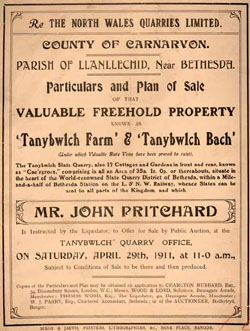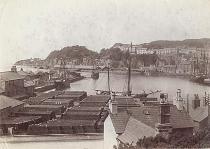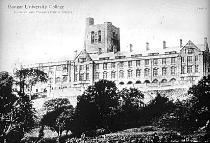Industry - The Welsh Slate Areas
The Arfon Slate Area The slate beds of Caernarfon
stretching from the area from Bethesda via
Llanberis, Moel Tryfan and Nantlle to
Penygroes are of Cambrian formation, and
include two of the largest quarries in the
world, namely the Dinorwig and Penrhyn
Quarries that are on opposite sides to the
Elidir Fawr. Whilst on the opposite side of
the valley to Dinorwig, above Llyn Padarn,
the Glynrhonwy Quarries are found. Six miles
south-west from Llanberis are the quarries
of the Nantlle Valley, where the slate
outcrops on the floor of the valley, and
whilst the quarries at Penrhyn and Dinorwig
are worked in open terraces, at Dorothea and
Penyrorsedd Quarries they are worked in deep
pits.
The Merionydd Slate Area
 The most important slate beds of the
Ordovician rocks are to be found around the
Blaenau Ffestiniog area, and since the slate
formations in Meirionydd generally dip deep
under the mountains, the slate is mined. To
the north-east of Blaenau Ffestiniog are the
old quarries at Penmachno and Dolwyddelan.
Other commercial slate producing areas of
this period occur in the area from Cricieth
and Porthmadog, right, to the south-west, running
towards the River Conwy near Trefriw in the
south-east. The most important slate beds of the
Ordovician rocks are to be found around the
Blaenau Ffestiniog area, and since the slate
formations in Meirionydd generally dip deep
under the mountains, the slate is mined. To
the north-east of Blaenau Ffestiniog are the
old quarries at Penmachno and Dolwyddelan.
Other commercial slate producing areas of
this period occur in the area from Cricieth
and Porthmadog, right, to the south-west, running
towards the River Conwy near Trefriw in the
south-east.
Slate in Anglesey
In the past, roofing slates from this
period were also quarried in Anglesey during
the 1870's at the North Anglesey (Point
Aelianus) Slate and Slab Quarry (known
locally as Chwarel Sglaets) and from the
Baron Hill Slate Quarry near Llanfechell.
Some other areas
Slate quarrying also was undertaken at
Cedryn and Cwm Eigia, in the Conwy Valley,
and at Clogau, Foel Faen and Glyn Ceiriog ,
Denbighshire. The Berwyn or Clogau Quarry
near Llangollen that dates back to the
1770's is still in production.
The Slate Industry of the South West.
Most people regard the slate industry as
being synonymous with the northern areas
that dominates slate production, producing
between 80%-90% of slate in the countries of
Britain at its industrial peak. But one
cannot disregard the industry in North
Pembrokeshire, on the boundary with
Carmarthenshire and in the Cilgerran region
in Dyffryn Teifi.
During the second half of the nineteenth
century we read of around 100 quarries in
this area employing hundreds of workers.
Quarrying history here also dates back to
the time of the Romans, and slates were used
centuries later for roofing churches. Indeed
it is claimed that slates from this area
were used in the twelfth century to roof the
abbey at Whitland.
Slates were exported to Bristol and
Ireland in 1566 and George Owen rports that
in 1603 slates were exported from
Haverfordwest, Tenby and Pembroke. The
Cambro-Irish links were further developed
when 40,000 slates were exported to Ireland
in 1616 from various ports, whilst in 1639
30,000 slates were exported from Fishguard
alone.
It is true that by the eighteenth century
the quarries of Devon and Cornwall were
claiming more and more of the Bristol
Channel trade to Ireland, but the greatest
challenge to the industry in south west
Wales was the flooding of the Irish market
by the north Wales quarries. But despite
this and the fact that the quarries were
isolated from the populous areas of England,
industrial development in the south gave
fresh impetus to the quarries.
However revitalisation was not going to
be long lived. By 1876 another period of
decline had set in. By 1884 slate prices had
fallen to the levels of 1860 and
Pembrokeshire slate became unfashionable.
The situation improved by the 1890's but by
then only a few quarries had survived the
depression.
But on the other hand the fate and
reputation of the green slate was to fare
better in the twentieth century
 The new buildings of the University
College of Wales, Bangor in 1907 were to be
roofed with green slate. Since the green
slate quarries of Dyffryn Nantlle were not
in production green Pembrokeshire slate was
used; a decision that was not popular in the
Bethesda area at the time! By the 1920's and
1930's the blue-grey slate was regarded as
being unfashionable by architects and Davies
Bros of Porthmadog was supplying
Pembrokeshire Green to builders of the area.
Indeed the green slate quarries of Dyffryn
Nantlle were in production by 1910 to meet
the increased demand. The new buildings of the University
College of Wales, Bangor in 1907 were to be
roofed with green slate. Since the green
slate quarries of Dyffryn Nantlle were not
in production green Pembrokeshire slate was
used; a decision that was not popular in the
Bethesda area at the time! By the 1920's and
1930's the blue-grey slate was regarded as
being unfashionable by architects and Davies
Bros of Porthmadog was supplying
Pembrokeshire Green to builders of the area.
Indeed the green slate quarries of Dyffryn
Nantlle were in production by 1910 to meet
the increased demand.
The Gilfach Quarry to the east of the
River Cleddau produced green slate for
roofing purposes until 1987.
|